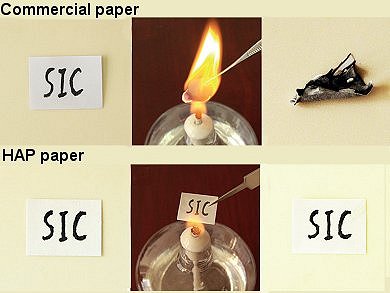Paper, made from cellulose, is a ubiquitous material used throughout the ages for writing or printing. However, owing to its flammable nature, it is easily destroyed. Also, paper yellows with age owing to the oxidation of the lignin present in it and it is susceptible to acid decay as cellulose produces formic, acetic, lactic, and oxalic acids. These drawbacks make paper less than ideal for the long-term storage of hard copies of data.
To combat this, Ying-Jie Zhu and co-workers, Shanghai Institute of Ceramics, China, have developed paper made from inorganic hydroxyapatite (Ca10(OH)2(PO4)6; HAP), a well-known member of the calcium phosphate family with high biocompatibility and essentially no toxicity. The team synthesized ultralong HAP nanowires by using calcium oleate as a precursor. When a dispersion of the ultralong HAP nanowires in ethanol was stirred with a glass rod, the HAP nanowires formed long fibers (28 mm) that exhibit very high flexibility. Sheets of paper could then be formed from these fibers by simple suction filtration.
The resulting paper is white in color, highly flexible, nonflammable, and can be written or printed on like cellulose-based paper. Unlike commercial printing paper, which catches on fire immediately on heating with a spirit lamp and is incinerated to ash in seconds, the HAP paper is well preserved even after being heated for 5 min, and no visible damage is observed to the paper or the text (see figure).
The HAP paper can also be used as an adsorbent for organic pollutants; it exhibits high adsorption capacities for various organic pollutants, for example, 7.3 g g−1 for chloroform, and it allows both the paper and absorbed organic pollutant to be easily recovered and recycled.
- Highly Flexible and Nonflammable Inorganic Hydroxyapatite Paper,
Bing-Qiang Lu, Ying-Jie Zhu, Feng Chen,
Chem. Eur. J. 2014.
DOI: 10.1002/chem.20130443



